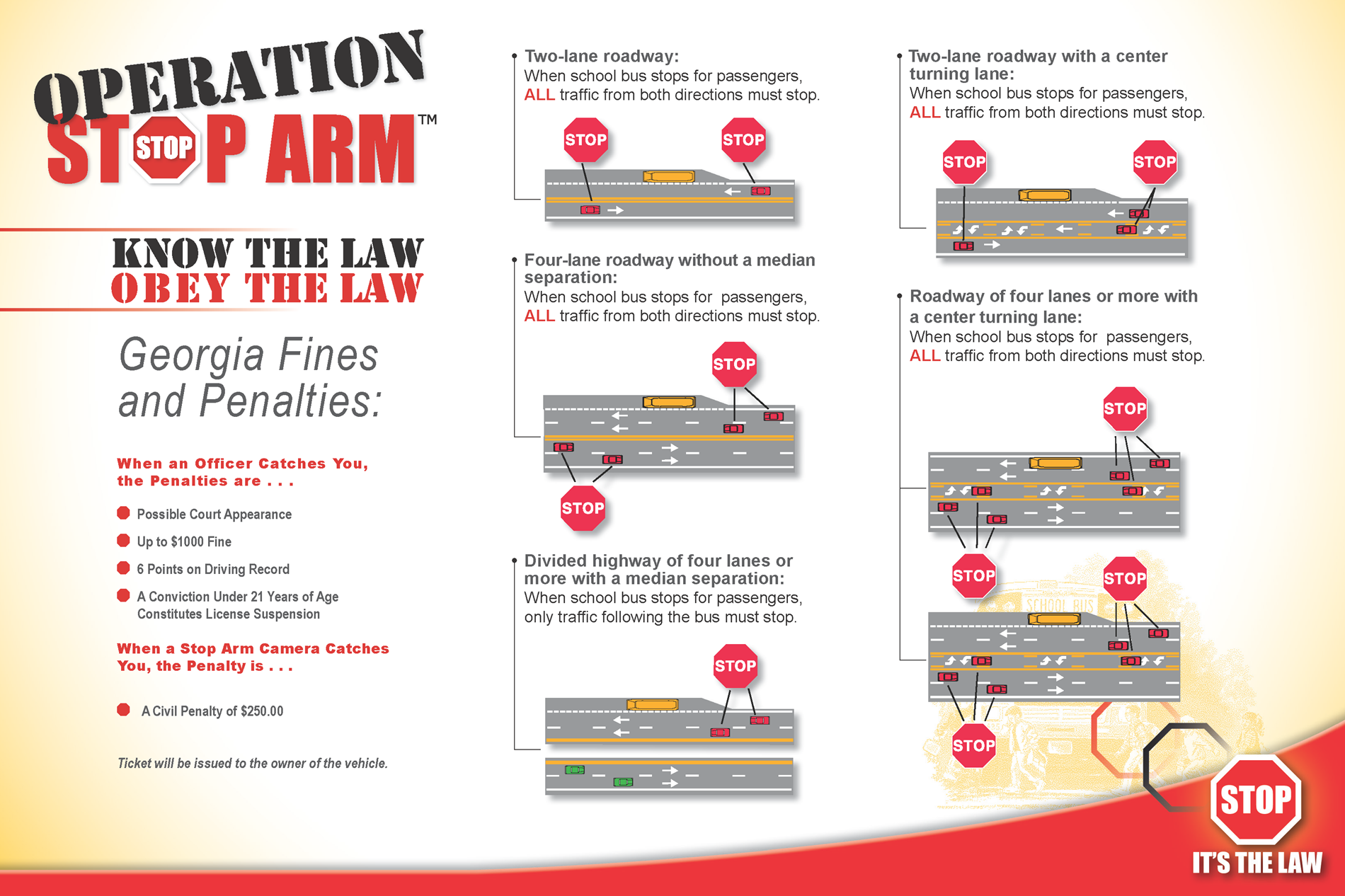School Bus Safety
Safety Tips for Students
- Allow enough time in the morning for unhurried, calm school preparation.
- Leave the house on time and allow for weather. Plan to arrive at the bus stop 10 minutes before the scheduled pick-up time.
- Carry everything in a backpack/school bag so items won’t be dropped along the way.
- Wear bright, contrasting colors so children will be more easily seen by drivers. A piece of high-visibility, reflective tape on coats and backpacks also helps.
- Young children should be supervised on the walk to the bus stop. Older children should walk in groups. There is safety in numbers and groups are easier for drivers to see.
- If a rider must cross the street, look left, right and then left again. Do the same thing at driveways and alleys. If cars are blocking the view, go to the nearest corner to cross.
- Always walk on the sidewalks. If riders must walk on roads with no sidewalk, face traffic and stay off the road as much as possible.
- While at the bus stop, wait quietly in a safe place away from the road.
- Children should not play running games or push and shove at the bus stop.
- Stay out of the road! Stay at least 12 feet (six giant steps) from the road while waiting for the bus.
- Children may neither go to other bus stops nor should they chase the bus if they miss boarding at their assigned location.
- Avoid any activity such as wearing earbuds or earphones that would prevent one from hearing the bus driver or being alerted to dangerous traffic conditions.
- Line up away from the street as the school bus approaches.
- When the bus approaches, step back at least six giant steps from the curb so the bus driver can pull up.
- Do not run alongside the bus while it is moving. Wait until it comes to a complete stop, the door opens, and the driver signals to enter.
- If a rider must cross the street in front of the bus, walk on the sidewalk or along the side of the road to a point at least 12 feet ahead of the bus before you cross. Be sure that the bus driver can see the student and that the student can see the bus driver. Wait for the hand signal from the bus driver before crossing street, checking right and left to make sure that traffic has stopped.
- Enter the bus in line with the younger students in front.
- Hold the handrail while going up the stairs to avoid falls. Go directly to a seat.
- If something is dropped, never immediately pick it up. First, tell the driver and follow the driver’s instructions. The driver may not see a child bent over to pick up an object.
- Stay in your seat while the bus is moving.
- Sit quietly in your seat. The bus driver needs to concentrate on the road. Lots of students talking very loudly is distracting, and it’s the driver’s job to get you to school safely.
- Never put your head, arms or hands out the window.
- Keep the aisles clear- someone may trip over a backpack or lunchbox.
- Before taking the last step off of the bus, stop and look left and especially right for possible traffic coming alongside of the bus. Be aware of the street traffic and make sure it has stopped.
- Secure lose drawstrings or other objects that may get caught in the handrail or door of the bus. Riders should not use earbuds or other devices that would prevent them from being alerted to danger. Instead focus all attention on moving safely away from the bus. Walk at least 12 feet away from the bus to clear the danger zone.
- Never walk behind the bus. ALWAYS cross in front of the bus.
- If something is dropped, never immediately pick it up. First, tell the driver and follow the driver’s instructions. The driver may not see a child bent over to pick up an object.
- If it is necessary to cross the street, walk on the sidewalk to a point that’s at least six giant steps ahead of the bus before crossing. Make eye contact with the bus driver, and stop and wait until the driver signals to cross to the center line of the road. Then wait for the driver to signal to continue crossing to the other side of the road. Always look both ways before crossing the street.
- Once on the other side, if possible, keep moving until at least 12 feet away from the side of the road.
- The 12 foot area surrounding the bus is considered the “Danger Zone.” This is the area in which it is most difficult to see children around the school bus. Riders should take six giant steps away from the bus when leaving the bus and always wait for the bus driver’s signal before crossing.
- Whenever anyone meets a child at the bus stop after school, wait on the side where the child will be dropped off. Children may dash across the street, excited to see their greeter.
Safety Tips for Drivers on the Road
- Be aware of school zone signage and reduce speed in school zones during posted hours.
- Be ready to stop at all times. Children do not always notice oncoming traffic.
- Always try to make eye contact with children who are waiting to cross the road.
- Be patient and wait for children to complete their crossing before proceeding.
- Stop when a Crossing Guard enters the street to control traffic. Wait till you are given the clearance to move.
- Never try to pass a bus that has stopped to let children off. Wait until the stop sign on the side of the bus has been retracted before proceeding.
- When backing out of a driveway or leaving a garage, watch out for children walking or bicycling to school. Better yet, walk around your car or out to the sidewalk to check for any children walking in your path before you get in.
- Drive slowly and watch for children walking in the street, especially if there are no sidewalks. Also be aware of children playing or waiting around bus stops.
- Be alert and aware on the road. While children are typically taught about looking both ways, they could dart into the street without looking if they are late or distracted.
- When driving in neighborhoods with school zones, watch out for young people who may be thinking about getting to school, but may not be thinking of getting there safely.
- Learn and obey the school bus laws in your state. Learn the "flashing signal light system"
that school bus drivers use to alert motorists of pending actions:
- Yellow flashing lights indicate that the bus is preparing to stop to load or unload children. Motorists should slow down and prepare to stop their vehicles.
- Red flashing lights and extended stop arms indicate that the bus has stopped, and that children are getting on or off. Motorists must stop their cars and wait until the red lights stop flashing, the extended stop sign is withdrawn, and the bus begins moving before they can start driving ag
Frequently Asked Safety Questions
Georgia Laws
(a) Except as provided in subsection (b) of this Code section, the driver of a vehicle meeting or overtaking from either direction any school bus stopped on the highway shall stop before reaching such school bus when there are in operation on the school bus the visual signals as specified in Code Sections 40-8-111 and 40-8-115, and such driver shall not proceed until the school bus resumes motion or the visual signals are no longer actuated.
(b) The driver of a vehicle upon a highway with separate roadways that are separated by a grass median, unpaved area, or a physical barrier need not stop upon meeting or passing a school bus which is on the separate roadway or upon a controlled-access highway when the school bus is stopped in a loading zone which is a part of or adjacent to such highway and where pedestrians are not permitted to cross the roadway.
(c) Every school bus driver who observes a violation of subsection (a) of this Code section is authorized and directed to record specifically the vehicle description, license number of the offending vehicle, and time and place of occurrence on forms furnished by the Department of Public Safety. Such report shall be submitted within 15 days of the occurrence of the violation to the local law enforcement agency which has law enforcement jurisdiction where the alleged offense occurred.





